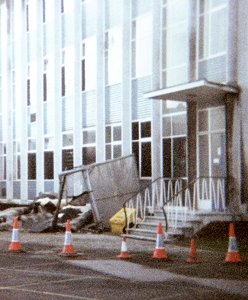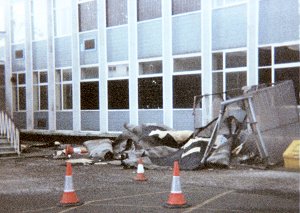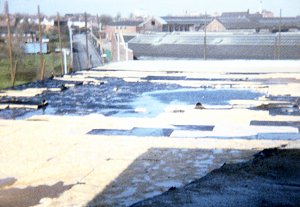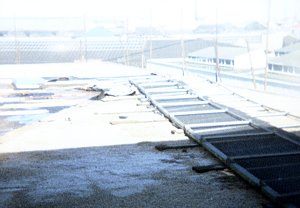Moving in Building of the MEB offices, stores and workshops started in the late 50s. The site, formerly occupied by Midland Tar Distillery, caused the building company, T & G Construction (a part of Tarmac) many problems, one of which was that they had to abandon piling steel girders and construct the buildings on concrete rafts. This meant there would be no cellars in the main office building, nor inspection pits in the garage workshops. It was said at the time that the ground was a sort of tar lake. The inevitable building delays meant that the office block was not quite ready when we moved from the Darlington Street and Red Lion Street offices on 31st December 1960 and 1st. January 1961. Workmen were still in the building lay tiles and electricians were still working laying and connecting cables. Into this chaos came the moving contractors, Pickfords, with all our office equipment and documentation; and the staff were left to sort it all out. The first thing we found was that the office plan, which we had been given to organise what would go where, had not taken into account the concrete pillars that jutted out from the walls, so filing cabinets did not fit in as planned. The next thing was that nobody had told us that there was no cellar, so historical documents meant to be stored there were dumped in one of the cloakrooms. We also found that some of the desks, chairs and equipment - much of it old and fragile - had collapsed during the move and carpenters had to be called in to repair them. Despite all obstacles we managed to sort out some sort of order ready for Monday morning opening on the 2nd January 1961.
The Stores and Workshop buildings were not ready for occupation until 1962 and again problems came to light. There were no offices for the electrical contracting and service office staff and part of the workshop area was hastily cleared for their use. The heating did not work properly, the floor was bare concrete and it was cold and draughty. It was not until many years later that a proper floor was laid, a ceiling fitted and windows draught proofed with secondary glazing. Both buildings were poorly and hastily built with many faults. The windows did not fit, the underfloor heating only worked in some areas and office space was too small. The first heavy rains flooded the ground floor offices so specialist firms had to be called in to seal all the windows and adjust them to try to stop draughts. The design of the buildings is unique to MEB. Their other offices throughout the Midlands electricity area were built to the same design and can easily be identified. As Major Street was one of the first, let's hope the others did not have the same problems. The work of Consumer Records - the common round In the early 1960s nearly every documents was raised, actioned and completed manually. This also applied to the updating of existing records, new records and follow up of outstanding or uncompleted work. The Consumer Records Department consisted in those days of a Prepayment Records Section, a Meter Reading Section, a Credit Sales Section and a Documentation section. All applications for supply came through the C.R.O. via the post, shops (service centres) or visits to the office. Matters needing action included requests for:
All instructions were issued on Instructions to Service Men (I.S.M.s) and were used for all types of work. For each new supply a consumer's record card was raised which contained the address at which the supply was required, the I.S.M. number raised and the date raised. It was then filed with the application form in a "new supplies" file until mains and metering were completed. On completion of both the record card was updated with mains details and meter details. A meter reading sheet was raised or a prepayment record card, giving details of the supply address, the date the meter was fixed and reading details of meter. The record was then filed in address (street name) and district order. The application form was filed in a separate file in surname order. The meter reading sheet was allocated a day of reading and a walk order number and was then forwarded to the Area Billing Section with the I.S.M. for I.B.M. billing records to be raised. The pre-payment cards were passed to the Prepayment Section for allocation of a date of emptying and order number; and also the card (which included copy for the consumer) to be filed, ready for emptying the meter on its allocated date. Any change to the consumer record arising from meter change, tariff change, change of occupier, disconnection of supply [final reading or non-payment of account], reconnection of supply, additional load, alteration of postal or billing address etc. was updated on the record card and other records either by an I.S.M. or change of address form. Periodical checks were made on all outstanding I.S.M.s. Reasons for non-completion were noted, where they were held, or a note was made that no reason for non-completion was found. The depatmnent concerned was urged to complete the work. Completed and fully actioned I.S.M.s were filed in number order and kept for one year. The work of Consumer Records - the uncommon task This all sounds quietly efficient but in real life it was often frantic up to the point of chaos. Record cards got misfiled; reading sheets and pre-payment cards went astray; I.S.M.s were lost or sent to wrong departments; duplication of work occurred. Because the I.S.M. was used by men on site in all weathers they were sometimes returned in very poor condition with details unreadable. Add to this the out of hours work carried out by the emergency services on "no supply" calls, where they may have by-passed a meter to give the consumer supply or, in case of a new occupier, they may have replaced the main fuses. Also there were meter mechanics who attended to "coin stuck" or "coin mechanism not working" call outs. They could replace or repair the coin mechanism but this would amend the coin register which would have to be adjusted on the prepayment record. In the cases where they were unable to repair the mechanism they would bridge it out and request the meter to be changed on a "blue note" (service record sheet). Sometimes the elements were against us. Arriving at work one day, in the late 80s or early 90s, after a night of storms, I took these photos of some of the damage done.
The Introduction of Computerisation The initial computerisation was for the billing of quarterly credit consumers only. Prior to its introduction all consumer records were required to have a nine digit reference allocated, which indicated the area office, district office, day of reading, zone and walk order number; added to this would be a computer check digit and a consumer digit [1-9]. The I.S.M. was replaced with Service Instructions, Connection Instructions and Disconnection Instructions. These were in numbered books of fifty instructions, in triplicate. The first two copies were issued to the relevant section who would use the second copy as a control. The third copy was retained for follow up of outstanding documents by the Records Office. When the quarterly billing was computersised, the computer held the name and supply address, billing address if different to supply address, details of make, type, certification, number, ampage, the meter reading last billed and if the supply was disconnected (change of tenancy or non-payment). With computerisation came a change in the set up of the Records Office. This was due to work formerly carried out at Area Office being transferred to the District Office. Such work included:
The office was separated into three sections
Over the following years the computer took over the control of other customer services and was able to:-
New systems, such as card meters, were introduced which helped reduce the need for disconnection of supply for non-payment. Even the old coin prepayment meters became virtually obsolete as they are no longer emptied by the supply company, the consumer having the key and being responsible for the payment of a quarterly account when due. Various other amendments to work procedures and follow-up have occurred with the introduction of "Computer Data Control". These include the issuing of password codes to individual members of staff which limits their access to certain records and systems. Future and Farwell Technology will continue to provide new systems controlled by the computer but one thing will always remain. The system will only be as good as the humans who design it, controls it or use and amend its contents. MEB is no longer with us. Its functions have been split up under various bodies such as N.Power, G.P.U. Power UK and Midland Electricity Contracting. Their customers are no longer confined to the old borders and could stretch nationwide. The old district offices, area offices and divisional offices are no more and are closed or used as work depots. Wolverhampton MEB is empty, slowly decaying, its once busy offices and stores/workshops now just a memory of the past. Everything is centralised and performances monitored to meet targets. That would seem to be the way forward but …. I still remember, with great nostalgia, the MEB of yesteryear, its employees who became friends, a place of work that was a pleasure to go to. |






